April 30, 2018 – Jamestown, Virginia
Some of us might remember the 1995 Disney movie Pocahontas, in which the young Powhatan Indian maiden is romantically involved with one of the founders of Jamestown, Captain John Smith. It followed 1994’s The Lion King, so you may still have had the latter VHS tape in your VCR and missed it. We did a little digging to find out just what happened at this historic village, and if the young native really had a thing for the dashing Englishman.
Jamestown is the first successful English settlement in North America. Captain John Smith was aboard a three-ship expedition that established James Fort on what is now known as the James River. It lies a mere 3 miles from the center of Williamsburg, Virginia, which we visited in our last post. They arrived in late April of 1607, finding a place they thought was graced with fresh water. That was later known to be the result of snow melt, with summer revealing the area’s water to be brackish. They were agriculturally ill-equipped, and 80% of them perished the next winter during a period known as the Starving Time. It didn’t help that the settlers weren’t getting along with the natives, either. According to Smith he was captured by the Powhatans and nearly executed at one point, only to have Pocahontas throw herself across his body to save him. Pretty romantic, but not the complete story. More on that in a bit.
Following those difficult first years, Jamestown flourished and was the capital of Virginia from 1616 to 1699. Eventually it was known as James City. In 1698 the capitol building burned, so the decision was made to move the seat of power to Williamsburg. The little settlement by the James River eventually disappeared, except for the brick church tower that the colonists had built. The property changed hands a few times and was eventually donated to the Association for the Preservation of Virginia Antiquities in 1893. That non-profit organization is now known as Preservation Virginia. It was believed that the original townsite had eroded into the river. The organization received federal assistance to build a seawall to protect what was left.
On April 30, we went to check this place out. We weren’t quite sure where to go, as there are two locations that are administered by three organizations. Bear with me on this. The Commonwealth (state) of Virginia owns a recreated living history museum called Jamestown Settlement just downriver from the original site. We chose not to visit there, opting to instead see the actual place where the colony existed. The Preservation Virginia site is immediately adjoined upriver by New Town, the direction Jamestown grew as it developed. New Town is administered by the National Park Service, and was excavated beginning in the 1930’s. Those digs are considered to be complete. It is confusing that those two sites are presented together as Historic Jamestowne. With Preservation Virginia’s involvement a separate $5 per person fee was charged, over and above our annual NPS pass. There is no choice to go only to the National Park.
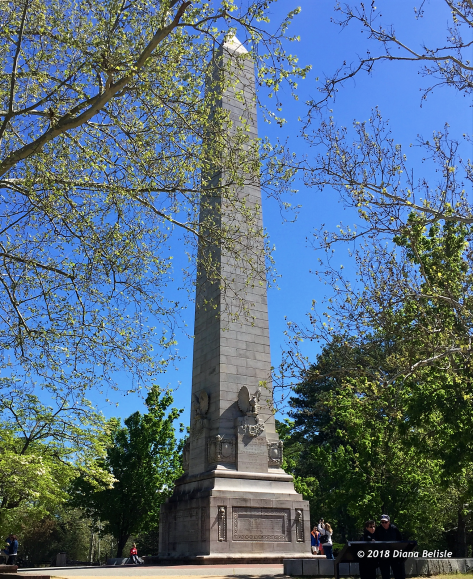
Upon entering the park, we were greeted by this large monument that commemorates the founding of Jamestown. We decided to join in on the archaeologist’s tour, which met in the shadow of the obelisk. So if the original townsite was washed into the river, what are they digging for? Well, in 1994, a man by the name of Dr. William Kelso convinced Preservation Virginia to let him dig and see what he could find.
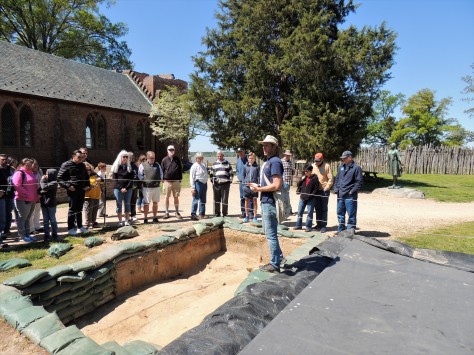
Our tour guide, Danny Schmidt, explained to us how they found the impressions of the fort’s posts in the soil. He joined Kelso right at the start of the project when he was just 16 years old and has been digging ever since. He bolstered his on the site experience with official degrees, and is now Senior Staff Archaeologist. He repeatedly commented that he was in the right place at the right time and feels very lucky to have spent his career in this location learning from Dr. Kelso.

It is very clear where a trench was dug and where the posts were placed. When the posts rotted, the impressions in the soil left a different color. The walls of the fort were quickly reestablished, finding that only a small portion of the structure had washed away.
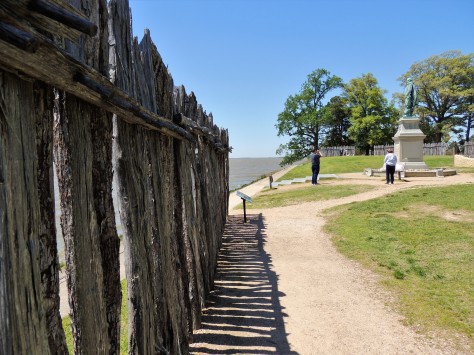
Looking down this wall to the point in the river where the far wall would intersect, shows how tiny that lost section is. Danny took us through the discoveries he and the team made, explaining how the dried up wells and basements of burned structures were used as dumps. As they found them, thousands of artifacts were brought up to help tell the story of Jamestown. Comparing what they were finding to historical accounts from the colonists, the archaeologists were able to even identify some of the human remains that were buried there. Schmidt was very interesting to listen to, telling about the times he met George W. Bush and Queen Elizabeth II, along with how the archaeology team determined what each found object was telling them.

The group is currently excavating the earth under the brick church that was originally built in the 17th century. This version is from the 1920’s, although the attached tower is said to be original. Also, there is a museum on the property which displays many of the artifacts found since Kelso started digging.
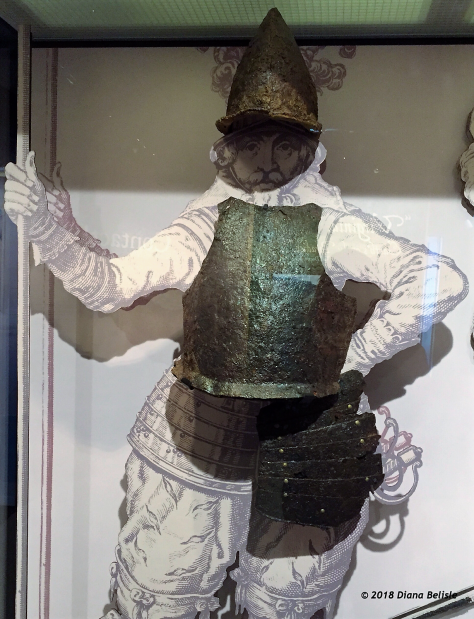
This armor was found in one of the wells. It is still in pretty good shape, considering it is 400 years old!

This tag was probably affixed to a crate of supplies that was brought from England. The old English spelling had it listed as Yames Towne. This tag flew on the space shuttle Atlantis to commemorate the 400th anniversary of the settlement. It logged a lot more miles on that trip than it did on it’s first one!
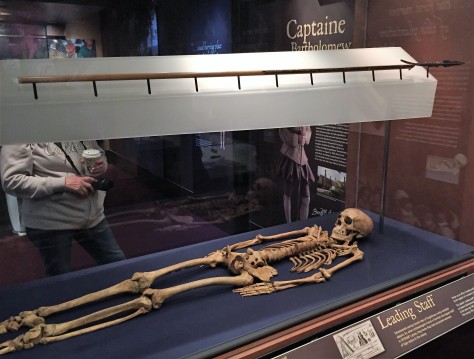
And this guy is Captain Bartholomew. They determined it by his bone structure, the staff he was buried with, and the location and direction of his grave. Schmidt even explained that they can determine what area of England a person would have come from, as the water in each place leaves different markers on the bones. Amazing stuff. They also found the bones of a young girl that was cannibalized during the Starving Time.
So back to our Disney story. Danny told us about how they ended up finding the original church, along with the graves of four people from the settlement.
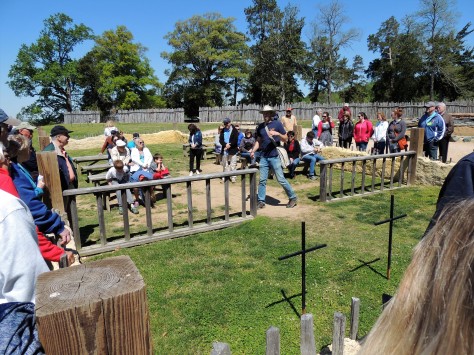
He even showed us the spot where Pocahontas was married to….John Rolfe. Huh? What happened to John Smith? He had left town in late 1609. As far as our young Powhatan maiden, it turns out that she was captured and held for ransom by the English in 1613. She converted to Christianity and married Rolfe in 1614. He was the person who introduced tobacco to the New World as a cash crop. Pocahontas bore their son in 1615 and the three set sail for England in 1617. She died soon after of unknown causes at the young age of 20 to 21 years old. She is buried in the church in Gravesend, England.

Here are our feet on the exact spot that the Rolfes would have taken their vows. Pocahontas would have been wearing pink laces. 🙂

A selfie after the ceremony and we were on our way to discover the third corner of the historic triangle: Yorktown. We will take a look at that in our next post, so be sure to stay tuned. We found some nifty little tidbits while we were there. Until then, don’t forget to “paint with all the colors of the wind” in your travels! (We still love a little Disney now and then!) 🙂
As stated earlier, there is an additional $5 per person charge to enter Historic Jamestowne, even if you hold an annual NPS pass. Preservation Virginia also asks for donations during the Archaeologist Tour and again upon entering the museum, even though the first additional fee goes to them. In addition, this was the first park we had ever seen that charged for a Junior Ranger book. While it was only $1, we were concerned that some parents would forego having their children participate in the activity, thereby putting a roadblock into what Preservation Virginia and National Parks are trying to accomplish. Perhaps they will rethink that in the future.
Jamestown Settlement is a completely separate location that charges its own fee. It is a recreated living history museum owned by Commonwealth (state) of Virginia. We did not visit this location.

I can’t wait to visit Virginia and see all this history you are seeing.
Sorry we missed the ceremony, but those laces can’t be beat!
Thanks for the tip on the NP fees.
LikeLiked by 1 person
You’re welcome, Brenda!
LikeLike
You gave a great tour! Sadly, not all park sites can afford to offer a free Junior Ranger program, especially if they don’t have partners or a cooperative history assoc. Sure hope you paid the dollar. 😉
LikeLiked by 1 person
When we asked, the impression we got was that it had to do with Preservation Virginia being involved. We chose to pass, as no one could tell us what PV even was. Had the information desk staff been more helpful, we might have done the book. They were actually a bit rude. I don’t want that to reflect on the park though, as we eventually found out their mission…which is pretty cool, Gaelyn!
LikeLiked by 1 person
I do remember about the posts in the sand and the different colors. Very interesting stuff!
LikeLiked by 1 person
That’s amazing how they can figure that out, isn’t it Debbie?
LikeLike
At least Disney gets the music right 🙂 Very informative post! Would love to visit there someday.
LikeLiked by 1 person
Lots to do in that area!
LikeLiked by 1 person
What an amazing career Danny has enjoyed!! It’s amazing to me that we are still unearthing historical discoveries, and what experts can now learn about the who’s and what’s. Great stuff. I hope Pocohontas found happiness in her real life story 🙂 It’s sad to hear the NPS hasn’t adequately trained their peeps in explaining the additional fees. I don’t mind paying more if I understand the purpose.
LikeLiked by 1 person
Exactly, Jodee. 😊
LikeLike
Thanks for describing your experience in such an engaging manner. I enjoy hearing about the digs that are uncovering our history. It’s on our list to spend a few weeks volunteering at one of them.
LikeLiked by 1 person
If you get a chance to go there, try to get on Danny’s tour, Bonnie. He was excellent!
LikeLike
I did not know that Pocahontas had died so young, I always assumed that she lived a lot longer!
LikeLiked by 1 person
I was surprised to hear that also, Jim. I do know that a lot of the natives died young from diseases brought over from Europe, as there weren’t any natural defenses in their systems. Could have been something else though in Pocahontas’ case.
LikeLike
Really Interesting and that armor was really cool
LikeLiked by 1 person
It certainly was interesting, Tracy. I can’t imagine what the archeologist who found that armor must have thought when he or she pulled it out of the ground. Their museum was filled with remarkable artifacts; almost all which were found in a relatively short period of time. It was a great way to spend a day!
LikeLike